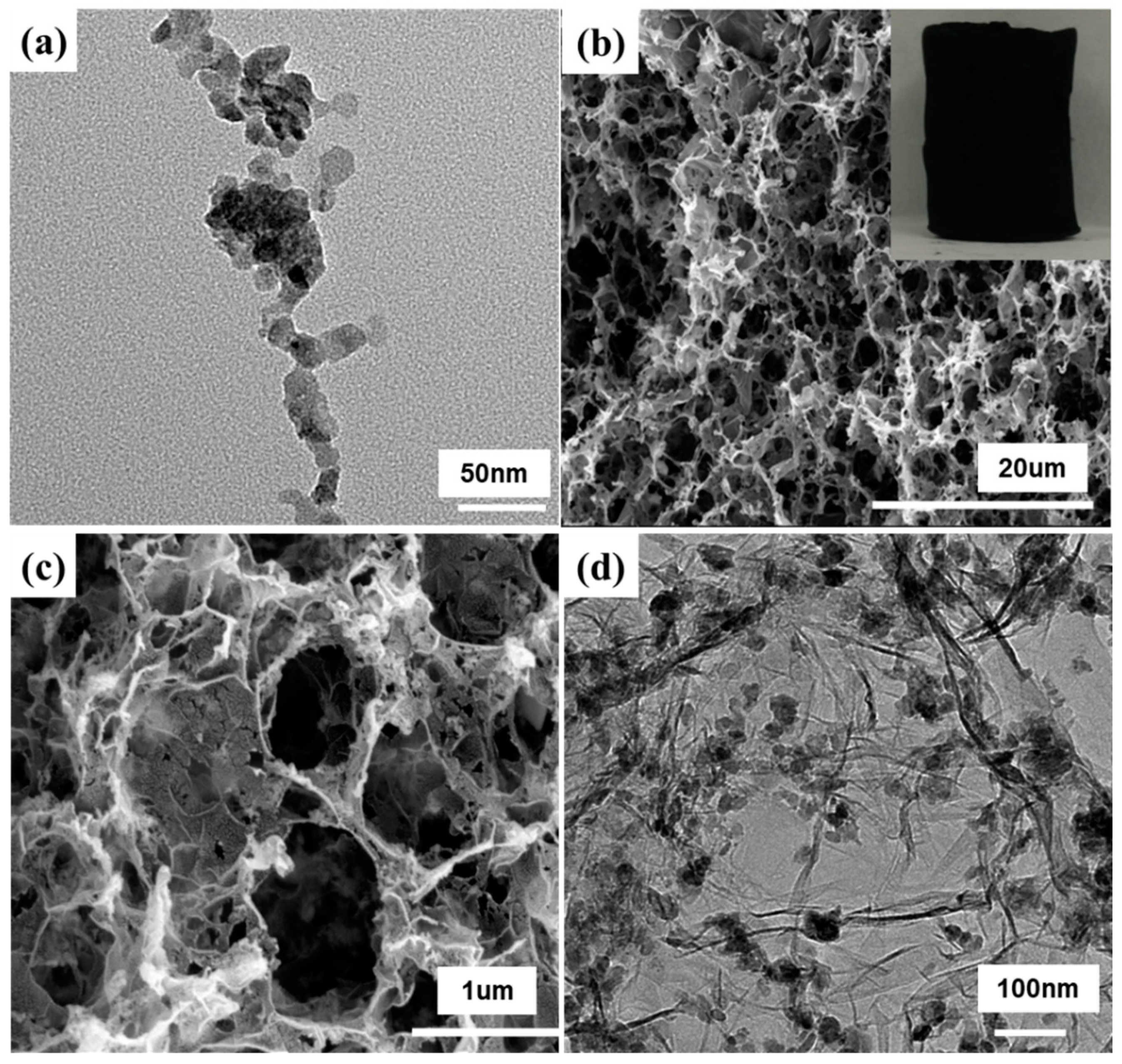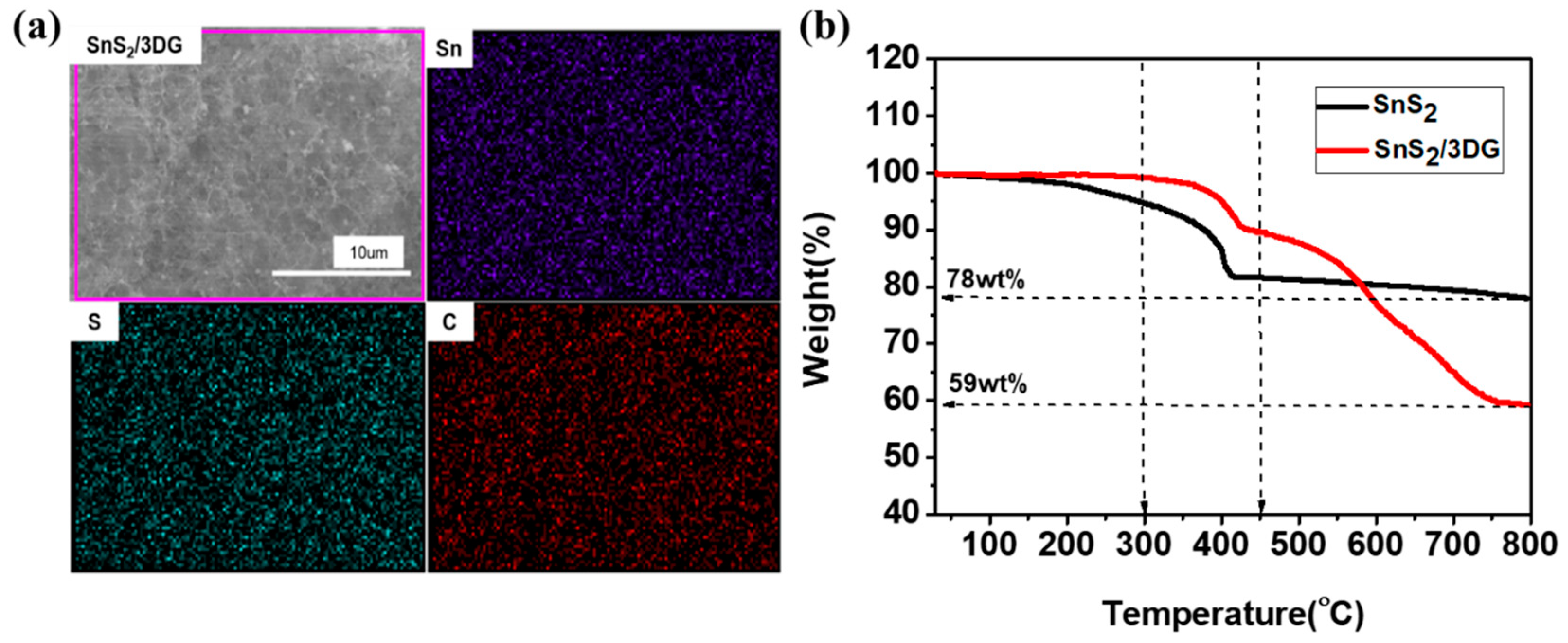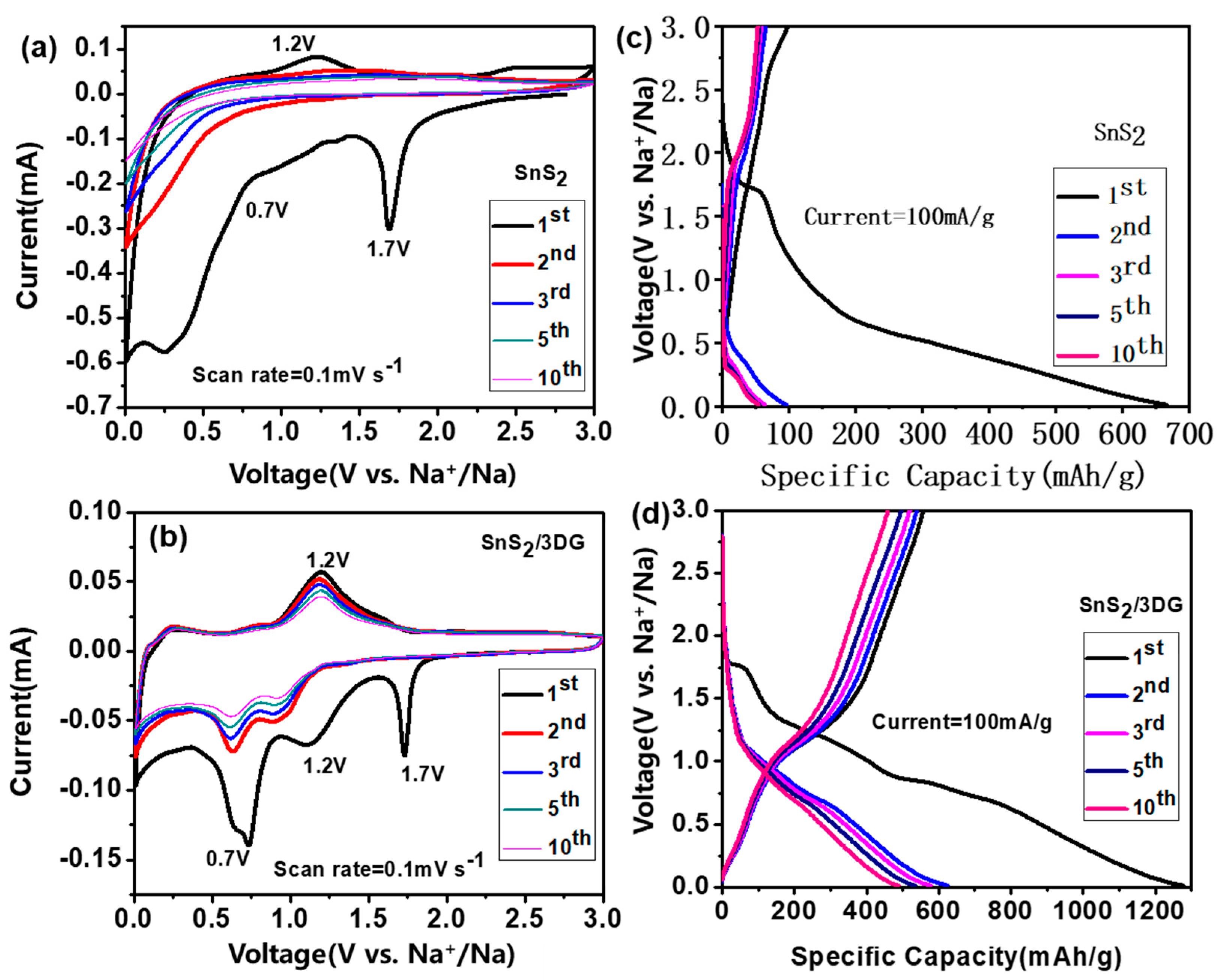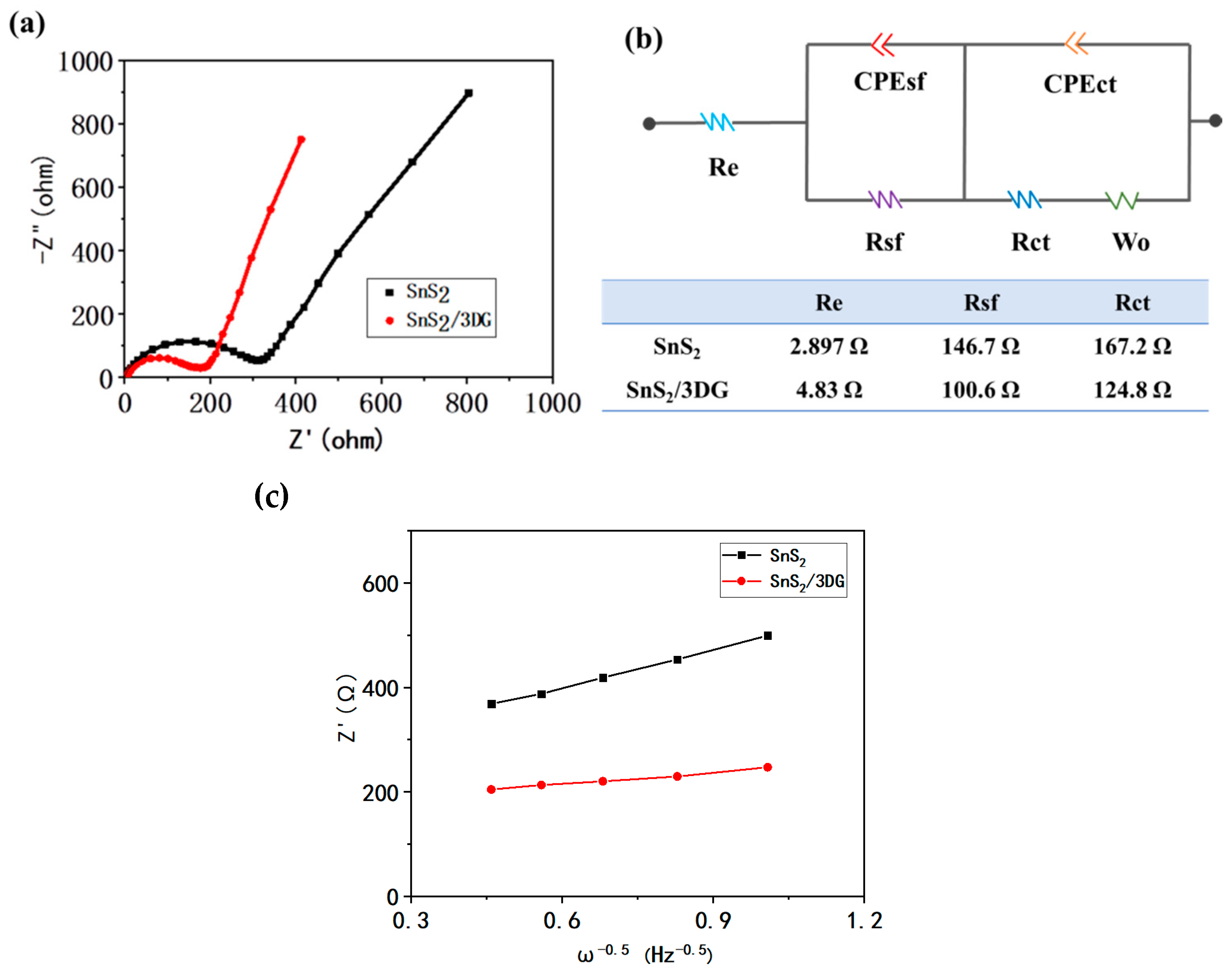SnS2 Nanocrystalline-Anchored Three-Dimensional Graphene for Sodium Batteries with Improved Rate Performance
Abstract
:1. Introduction
2. Materials and Methods
2.1. Preparation of the SnS2 Nanocrystalline
2.2. Preparation of SnS2/3DG Composite
2.3. Characterizations
3. Results and Discussion
3.1. Structure and Morphology Analysis of SnS2 and SnS2/3DG Composites
3.2. Electrochemical Analysis of SnS2/3DG Composites
4. Conclusions
Author Contributions
Funding
Conflicts of Interest
References
- Zhao, H.; Lei, Y. 3D Nanostructures for the Next Generation of High-Performance Nanodevices for Electrochemical Energy Conversion and Storage. Adv. Energy Mater. 2020, 10, 2001460. [Google Scholar] [CrossRef]
- Wang, J.; Chao, D.; Liu, J.; Li, L.; Lai, L.; Lin, J.; Shen, Z. Ni3S2@ MoS2 core/shell nanorod arrays on Ni foam for high-performance electrochemical energy storage. Nano Energy 2014, 7, 151–160. [Google Scholar] [CrossRef]
- Fan, X.; Liu, X.; Hu, W.; Zhong, C.; Lu, J. Advances in the development of power supplies for the internet of everything. InfoMat 2019, 1, 130–139. [Google Scholar] [CrossRef] [Green Version]
- Hwang, J.Y.; Myung, S.T.; Sun, Y.K. Sodium-ion batteries: Present and future. Chem. Soc. Rev. 2017, 46, 3529–3614. [Google Scholar] [CrossRef] [PubMed] [Green Version]
- Fu, Y.; Wei, Q.; Zhang, G.; Sun, S. Advanced Phosphorus-Based Materials for Lithium/Sodium-Ion Batteries: Recent Developments and Future Perspectives. Adv. Energy Mater. 2018, 8, 2849–2877. [Google Scholar] [CrossRef]
- Pu, X.; Wang, H.; Zhao, D.; Yang, H.; Cao, Y. Recent Progress in Rechargeable Sodium-Ion Batteries: Toward High-Power Applications. Small 2019, 15, e1805427. [Google Scholar] [CrossRef] [PubMed]
- Deng, J.; Luo, W.B.; Chou, S.L.; Liu, H.K.; Dou, S.X. Sodium-ion batteries: From academic research to practical commercialization. Adv. Energy Mater. 2018, 8, 1701428. [Google Scholar] [CrossRef]
- Huang, Y.; Zheng, Y.; Li, X.; Adams, F.; Luo, W.; Huang, Y.; Hu, L. Electrode materials of sodium-ion batteries toward practical application. ACS Energy Lett. 2018, 3, 1604–1612. [Google Scholar] [CrossRef]
- Zhou, P.; Wang, X.; Guan, W.; Zhang, D.; Fang, L.; Jiang, Y. SnS2 Nanowall Arrays toward High-Performance Sodium Storage. ACS Appl. Mater. Interfaces 2017, 9, 6979–6987. [Google Scholar] [CrossRef]
- Jiang, Y.; Song, D.; Wu, J.; Wang, Z.; Huang, S.; Xu, Y.; Chen, Z.; Zhao, B.; Zhang, J. Sandwich-like SnS2/graphene/SnS2 with expanded interlayer distance as high-rate lithium/sodium-ion battery anode materials. ACS Nano 2019, 13, 9100–9111. [Google Scholar] [CrossRef]
- Kumagai, Y.; Burton, L.A.; Walsh, A.; Oba, F. Electronic Structure and Defect Physics of Tin Sulfides: SnS, Sn2S3, and SnS2. Phys. Rev. Appl. 2016, 6, 014009. [Google Scholar] [CrossRef] [Green Version]
- Chen, G.; Yao, X.; Cao, Q.; Ding, S.; He, J.; Wang, S. Flexible free-standing SnS2/carbon nanofibers anode for high performance sodium-ion batteries. Mater. Lett. 2019, 234, 121–124. [Google Scholar] [CrossRef]
- Man, X.; Liang, P.; Shu, H.; Zhang, L.; Wang, D.; Chao, D.; Liu, Z.; Du, X.; Wan, H.; Wang, H. Interface synergistic effect from layered metal sulfides of MoS2/SnS2 van der Waals heterojunction with enhanced Li-ion storage performance. J. Phys. Chem. C 2018, 122, 24600–24608. [Google Scholar] [CrossRef]
- Wu, P.; Du, N.; Zhang, H.; Liu, J.; Chang, L.; Wang, L.; Yang, D.; Jiang, J.-Z. Layer-stacked tin disulfide nanorods in silica nanoreactors with improved lithium storage capabilities. Nanoscale 2012, 4, 4002–4006. [Google Scholar] [CrossRef]
- Fan, Y.; Luo, Q.; Liu, G.; Wang, J.; Dong, X.; Yu, W. Synthesis of SnO2@ SnS2 core–shell nanorods by double crucible method and their photocatalysis. J. Mater. Sci. Mater. Electron. 2014, 25, 3801–3806. [Google Scholar] [CrossRef]
- Yu, J.; Xu, C.-Y.; Ma, F.-X.; Hu, S.-P.; Zhang, Y.-W.; Zhen, L. Monodisperse SnS2 nanosheets for high-performance photocatalytic hydrogen generation. ACS Appl. Mater. Interfaces 2014, 6, 22370–22377. [Google Scholar] [CrossRef]
- Zhou, X.; Zhang, Q.; Gan, L.; Li, H.; Zhai, T. Large-size growth of ultrathin SnS2 nanosheets and high performance for phototransistors. Adv. Funct. Mater. 2016, 26, 4405–4413. [Google Scholar] [CrossRef]
- He, M.; Yuan, L.-X.; Huang, Y.-H. Acetylene black incorporated three-dimensional porous SnS 2 nanoflowers with high performance for lithium storage. RSC Adv. 2013, 3, 3374–3383. [Google Scholar] [CrossRef]
- Liu, J.; Qi, Y.; Fu, B.; Dai, J.; Wang, Q.; Zhu, X.; Shi, X. Li+ diffusion kinetics of SnS2 nanoflowers enhanced by reduced graphene oxides with excellent electrochemical performance as anode material for lithium-ion batteries. J. Alloy. Compd. 2019, 794, 285–293. [Google Scholar] [CrossRef]
- Jiang, Z.; Zhang, D.; Yue, L.; Hao, C.; Wang, M.; Wang, X.; Bai, Y.; Lv, H.; Yao, Y.; Lu, S. One-step, simple, and green synthesis of tin dioxide/graphene nanocomposites and their application to lithium-ion battery anodes. Appl. Surf. Sci. 2014, 317, 486–489. [Google Scholar] [CrossRef]
- Chang, K.; Wang, Z.; Huang, G.; Li, H.; Chen, W.; Lee, J.Y. Few-layer SnS2/graphene hybrid with exceptional electrochemical performance as lithium-ion battery anode. J. Power Sources 2012, 201, 259–266. [Google Scholar] [CrossRef]
- Xie, X.; Su, D.; Chen, S.; Zhang, J.; Dou, S.; Wang, G. SnS2 Nanoplatelet@Graphene Nanocomposites as High-Capacity Anode Materials for Sodium-Ion Batteries. Chem. Asian J. 2014, 9, 1611–1617. [Google Scholar] [CrossRef] [PubMed]
- Cui, J.; Yao, S.; Lu, Z.; Huang, J.Q.; Chong, W.G.; Ciucci, F.; Kim, J.K. Revealing pseudocapacitive mechanisms of metal dichalcogenide SnS2/graphene-CNT aerogels for high-energy Na hybrid capacitors. Adv. Energy Mater. 2018, 8, 1702488. [Google Scholar] [CrossRef]
- Luo, B.; Hu, Y.; Zhu, X.; Qiu, T.; Zhi, L.; Xiao, M.; Zhang, H.; Zou, M.; Cao, A.; Wang, L. Controllable growth of SnS2 nanostructures on nanocarbon surfaces for lithium-ion and sodium-ion storage with high rate capability. J. Mater. Chem. A 2018, 6, 1462–1472. [Google Scholar] [CrossRef]
- Liu, H.; Deng, L.; Zhang, Z.; Guan, J.; Yang, Y.; Zhu, Z. One-step in-situ hydrothermal synthesis of SnS2/reduced graphene oxide nanocomposites with high performance in visible light-driven photocatalytic reduction of aqueous Cr (VI). J. Mater. Sci. 2015, 50, 3207–3211. [Google Scholar] [CrossRef]
- Yu, Z.; Li, X.; Yan, B.; Xiong, D.; Yang, M.; Li, D. Rational design of flower-like tin sulfide@ reduced graphene oxide for high performance sodium ion batteries. Mater. Res. Bull. 2017, 96, 516–523. [Google Scholar] [CrossRef]
- Wang, L.; Yuan, J.; Zhao, Q.; Wang, Z.; Zhu, Y.; Ma, X.; Cao, C. Supported SnS2 nanosheet array as binder-free anode for sodium ion batteries. Electrochim. Acta 2019, 308, 174–184. [Google Scholar] [CrossRef]
- Kumar, M.P.; Nidhi, M.; Srivastava, C. Electrochemical exfoliation of graphite to produce graphene using tetrasodium pyrophosphate. RSC Adv. 2015, 5, 24846–24852. [Google Scholar] [CrossRef]
- Wang, R.; Wu, S.; Lv, Y.; Lin, Z. Partially crystalline Zn2GeO4 nanorod/graphene composites as anode materials for high performance lithium ion batteries. Langmuir 2014, 30, 8215–8220. [Google Scholar] [CrossRef]
- Utyuzh, A.; Timofeev, Y.A.; Stepanov, G. Effect of pressure on Raman spectra of SnS2 single crystals. Phys. Solid State 2010, 52, 352–356. [Google Scholar] [CrossRef]
- Liu, X.; Qi, X.; Zhang, Z.; Ren, L.; Hao, G.; Liu, Y.; Wang, Y.; Huang, K.; Wei, X.; Li, J. Electrochemically reduced graphene oxide with porous structure as a binder-free electrode for high-rate supercapacitors. RSC Adv. 2014, 4, 13673–13679. [Google Scholar] [CrossRef]
- Niyogi, S.; Bekyarova, E.; Itkis, M.E.; Zhang, H.; Shepperd, K.; Hicks, J.; Sprinkle, M.; Berger, C.; Lau, C.N.; Deheer, W.A. Spectroscopy of covalently functionalized graphene. Nano Lett. 2010, 10, 4061–4066. [Google Scholar] [CrossRef] [PubMed] [Green Version]
- She, X.; Liu, T.; Wu, N.; Xu, X.; Li, J.; Yang, D.; Frost, R. Spectrum analysis of the reduction degree of two-step reduced graphene oxide (GO) and the polymer/r-GO composites. Mater. Chem. Phys. 2013, 143, 240–246. [Google Scholar] [CrossRef]
- Fan, L.; Li, X.; Song, X.; Hu, N.; Xiong, D.; Koo, A.; Sun, X. Promising dual-doped graphene aerogel/SnS2 nanocrystal building high performance sodium ion batteries. ACS Appl. Mater. Interfaces 2018, 10, 2637–2648. [Google Scholar] [CrossRef]
- Ma, C.; Xu, J.; Alvarado, J.; Qu, B.; Somerville, J.; Lee, J.Y.; Meng, Y.S. Investigating the energy storage mechanism of SnS2-rGO composite anode for advanced Na-ion batteries. Chem. Mater. 2015, 27, 5633–5640. [Google Scholar] [CrossRef]
- Zheng, J.; Xiong, X.H.; Wang, G.H.; Lin, Z.H.; Ou, X.; Yang, C.H.; Liu, M.L. SnS2 nanoparticles anchored on three-dimensional reduced graphene oxide as a durable anode for sodium ion batteries. Chem. Eng. J. 2018, 339, 78–84. [Google Scholar] [CrossRef]
- Liu, Y.; Kang, H.; Jiao, L.; Chen, C.; Cao, K.; Wang, Y.; Yuan, H. Exfoliated-SnS2 restacked on graphene as a high-capacity, high-rate, and long-cycle life anode for sodium ion batteries. Nanoscale 2015, 7, 1325–1332. [Google Scholar] [CrossRef]
- Zhang, S.; Zhao, H.; Wu, M.; Yue, L.; Mi, J. One-pot solvothermal synthesis 2D SnS2/CNTs hybrid as a superior anode material for sodium-ion batteries. J. Alloy. Compd. 2018, 737, 92–98. [Google Scholar] [CrossRef]
- Jeong, S.Y.; Ghosh, S.; Kim, J.-K.; Kang, D.-W.; Jeong, S.M.; Kang, Y.C.; Cho, J.S. Multi-channel-contained few-layered MoSe2 nanosheet/N-doped carbon hybrid nanofibers prepared using diethylenetriamine as anodes for high-performance sodium-ion batteries. J. Ind. Eng. Chem. 2019, 75, 100–107. [Google Scholar] [CrossRef]
- Zeng, L.; Zhang, L.; Liu, X.; Zhang, C. Three-Dimensional Porous Graphene Supported MoS2 Nanoflower Prepared by a Facile Solvothermal Method with Excellent Rate Performance and Sodium-Ion Storage. Polymers 2020, 12, 2134. [Google Scholar] [CrossRef]







| Systems | Capacity | Cycle Stability | Rtotal = Re + Rsf + Rct (Ω) | Reference |
|---|---|---|---|---|
| 3D SnS2/rGO | 0.1 A/g–754 mAh/g 2.0 A/g–401 mAh/g | 75.4% | 150 | Ref. [36] |
| Exfoliated SnS2/Graphene | 0.2 A/g–650 mAh/g 4.0 A/g–326 mAh/g | 66.6% | 100 | Ref. [37] |
| Flower-like SnS2/rGO | 0.05 A/g–521 mAh/g 0.4 A/g–200 mAh/g | 83.3% | 400 | Ref. [26] |
| Free-standing SnS2/carbon nanofibers | 0.2 A/g–570 mAh/g 5.0 A/g–247 mAh/g | 81% | / | Ref. [12] |
| 2D SnS2/CNTs hybrid | 0.05 A/g–476 mAh/g 3.2 A/g–265 mAh/g | 84.0% | 100 | Ref. [38] |
| NCNF/MoSe2 | 0.5 A/g–386 mAh/g 10.0 A/g–285 mAh/g | 91% | 300 | Ref. [39] |
| MoS2/3DG | 0.1 A/g–455 mAh/g 2.0 A/g–310 mAh/g | 80.0% | 75 | Ref. [40] |
| SnS2/3DG | 0.1 A/g–498 mAh/g 2.0 A/g–254 mAh/g | 67.0% | 230 | This work |
Publisher’s Note: MDPI stays neutral with regard to jurisdictional claims in published maps and institutional affiliations. |
© 2020 by the authors. Licensee MDPI, Basel, Switzerland. This article is an open access article distributed under the terms and conditions of the Creative Commons Attribution (CC BY) license (http://creativecommons.org/licenses/by/4.0/).
Share and Cite
Zeng, L.; Zhang, L.; Liu, X.; Zhang, C. SnS2 Nanocrystalline-Anchored Three-Dimensional Graphene for Sodium Batteries with Improved Rate Performance. Nanomaterials 2020, 10, 2336. https://doi.org/10.3390/nano10122336
Zeng L, Zhang L, Liu X, Zhang C. SnS2 Nanocrystalline-Anchored Three-Dimensional Graphene for Sodium Batteries with Improved Rate Performance. Nanomaterials. 2020; 10(12):2336. https://doi.org/10.3390/nano10122336
Chicago/Turabian StyleZeng, Li, Liping Zhang, Xingang Liu, and Chuhong Zhang. 2020. "SnS2 Nanocrystalline-Anchored Three-Dimensional Graphene for Sodium Batteries with Improved Rate Performance" Nanomaterials 10, no. 12: 2336. https://doi.org/10.3390/nano10122336
APA StyleZeng, L., Zhang, L., Liu, X., & Zhang, C. (2020). SnS2 Nanocrystalline-Anchored Three-Dimensional Graphene for Sodium Batteries with Improved Rate Performance. Nanomaterials, 10(12), 2336. https://doi.org/10.3390/nano10122336





